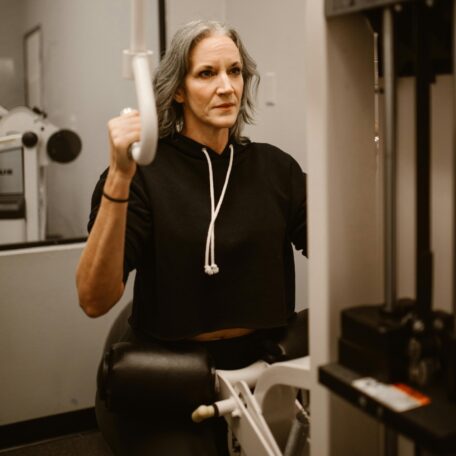“It’s as critical to your health as mammograms and annual doctor visits.”
– Holly Perkins, Certified Strength and Conditioning Specialist
What is strength training?
Strength training (also called resistance training or weight training) involves applying resistance to muscular contraction to build your muscle strength and endurance, using free weights, weight machines, resistance bands or even your own body weight. An effective program will have you progressively increase the weights as you become stronger, so that your muscle strength gradually improves.
The benefits of strength training for women after 50
You are never too old to gain muscle strength. Strength training has mental and physical benefits for people of all ages.
The documented benefits of training with weights after turning 50, include:
| Impact of strength training | Personal benefits |
| Improved posture, mobility, flexibility and balance | Makes you less likely to fall Supports your physical independence Allows you to fully participate in the activities of daily living |
| Improved muscle strength and tone | Protects your joints from injury |
| Increased muscle-to-fat ratio | Helps you to manage your weight |
| Prevention/improvement of chronic conditions | Helps you to manage your symptoms of diabetes, heart disease, arthritis, osteoporosis and depression |
| Increased bone density and strength | Reduces your risk of osteoporosis |
| Improved sleep | Helps you to avoid insomnia |
| Increased confidence and self-esteem | Makes you feel better about yourself |
Key health concerns for training over 50
Most women reach menopause between the ages of 45 and 55. For some women, the effects of menopause can significantly disrupt their daily activities and sense of well-being. Associated with menopause are increased risks of osteoporosis (bone thinning) and cardiovascular disease, even in women without any previous significant history. Women lose lean mass tissue at the rate of 5% per decade from their 30s, and will generally find they gain more belly fat after turning 50.
Setting up a strength training program for women over 50
- Implementing a pre-exercise screening tool
It is important that a pre-screening assessment is undertaken, especially for those new to fitness training and for older adults. A screening process will help to identify those women over 50 with medical conditions who may be at greater risk when exercising. AUSActive advocates the use of a pre-exercise screening tool and strongly advise you to consult with health professionals before starting a new fitness program.
2. Determining baseline fitness assessment
Older adults should take a baseline fitness assessment to determine their current exercise tolerance and to define their limits. If it is to be effective, a strength training program should be properly matched to the individual, with exercises prescribed at the intensity, frequency, and duration that the person can perform.
3. Designing a program
The Australian Government’s Department of Health has released Australian Physical Activity and Sedentary Behaviour Guidelines. The recommendations for older adults include light strength training 2 to 3 times a week, using exercises to work all the major muscle groups of your body (i.e., legs, hips, back, chest, abdomen, shoulders and arms). It is important for older adults to apply only low levels of impact on the muscles to avoid injuries. Elastic band exercises, for example, are ideal.
4. Starting strength training
Take time to learn the skills and correct techniques for exercising and lifting weights. Develop awareness of how to exercise safely. This will be very important for reducing your risk of injury and making your program effective.
A typical beginner’s program will involve 8 to 10 exercises across the body’s major muscle groups in 2 to 3 sessions per week. The average amount of repetitions for each exercise is usually 8 to 12.
There is a range of strength exercises available for you to work into your program. Be guided by your fitness instructor. Good instruction will advise you on why you are doing each exercise and learn how to do each exercise properly. For example, check out Holly Perkins’ 10 best strength-training moves for women over 50 (5)— along with her explanations about what makes each one so vital.
5. Monitoring progress
It is important to maintain a strength training program that results in muscle gains. Sometimes, a doctor or health care provider neglects to emphasise this. Under-dosed strength training programs are relatively ineffective and should be avoided. Instead, your program should have a goal of increased strength as compared to your original baseline measurements. The aim is to maintain good technique and use a resistant force/weight that will challenge you. Regular adjustments to the training variables (frequency, duration, sets and repetitions) will make you progress and improve.
Tailoring a program for women over 50
- Foster a safe and supportive environment
- Provide opportunities to socialise (e.g., over a cup of coffee after each session)
- Allow time for muscle recovery between sessions – at least 48 hours is usually required.
- Integrate cross-training with strength training, to support cardiovascular and aerobic development.
- Provide ongoing education, training and monitoring of skills and techniques for performing strength exercises effectively and safely.
If you’re interested in taking the first step towards a fitness career, check out our Personal Training Course.












